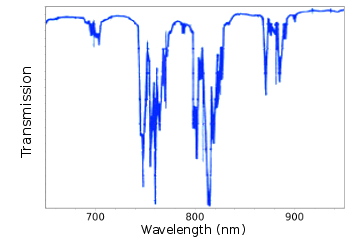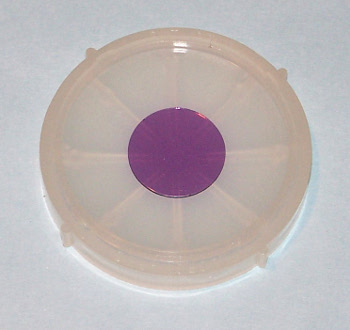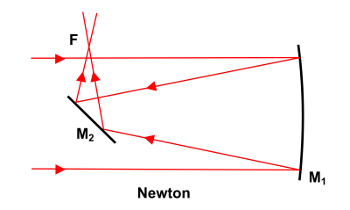Solar-Pumped Laser
September 20, 2011
The archetypal
aluminum garnet is
yttrium aluminum garnet (YAG,
Y3Al5O12), which is used as a
laser host.
Neodymium-doped YAG (
Nd:YAG) is an important commercial
solid state laser that emits at 1064
nm. The
neodymium atoms that substitute for about one percent of the
yttrium atoms in these solid state lasers absorb energy in two broad bands between 730–760 nm and 790–820 nm (see figure).

Relative optical transmission of neodymium-doped YAG.
Data from published sources.
Graph via (Gnumeric))
It's these absorption bands that allow efficient conversion of the pumped light energy into useful
infrared laser light that makes Nd:YAG such a commercial success. These absorption wavelengths overlap nicely with the spectral output of many
flash lamps and
light emitting diodes.
Many years ago, I did research on the
epitaxial crystal growth of layers of aluminum garnet for
optical waveguide applications.[1-2] I also prepared epitaxial layers of
chromium-doped YAG, which is interesting as a
tunable laser material. In that case, we wanted the
chromium to exist in the crystal as the Cr
4+ cation, so it was necessary to co-dope with
Ca2+ for
charge compensation.
As is often the fate of the
crystal grower, my very nice wafers of this material were never characterized by the
optical physicist for whom I had prepared them. As far as the
scientific literature is concerned, these crystals were never made, so it's important to choose your collaborators wisely.

A small wafer of neodymium gallium garnet (Nd3Ga5O12) in a two-inch wafer carrier.
Neodymium-doped oxides have this pleasant color, although the color is not as intense as for this crystal.
(Photo by author)
It's also possible to prepare (Nd,Cr):YAG with Cr
3+, and this leads to enhanced optical absorption at
visible wavelengths. Although not as bad as its
hexavalent cousins,
chromium (III) oxide is still a
nasty chemical; but it has a green color, and green is right in the middle of the visible spectrum. Cr
3+, when added to Nd:YAG, captures visible light and transfers its energy to excite the lasing neodymium atoms.
The absorption spectra of Cr
3+in YAG extends from 400-700 nm.[3] This enhanced optical absorption of visible light can be put to use in a
solar pumped laser. Furthermore,
ceramic processing techniques have advanced to the point at which you can prepare an
optically adequate laser without the expense of preparing a
single crystal.[3,4]
Recently, a team of scientists at the arcanely named
Uzbekistan Scientific and Production Association (Akadempribor) has been researching solar pumped (Nd,Cr):YAG ceramic lasers formed as thin slabs. These
slab lasers are placed in optical devices that resemble
Newtonian reflector telescopes (see figure). The
sunlight is concentrated by a one
meter diameter parabolic mirror into a focused spot of intense radiation about an inch in diameter that pumps the ceramic laser slab.

A Newtonian reflecting telescope. The solar pumped laser presumably has the same arrangement of optical elements with the slab laser replacing the secondary mirror (M2).
(Drawing by H. Hahn, via Wikimedia Commons))
Heat, of course, is the enemy of most good things, so it's necessary to extract heat from the ceramic laser with a
water-cooled heat sink. The Uzbekistan research team claims that their solar pumped laser should convert thirty-five percent of solar energy into laser light. Other solar pumped lasers have shown just one, or two, percent
efficiency.
More detailed information can't be found just yet, since the paper that describes this research is still in press. The paper, "Transformation of concentrated sunlight into laser radiation on small parabolic mirrors," by Shermakhamat Payziyev, Sagdilla Bakhramov and Abdugappar Kasimov will appear in the
Journal of Renewable and Sustainable Energy.
References:
- D.M. Gualtieri and R.C. Morris, "Epitaxial Waveguides of Aluminum Garnet," J. Appl. Phys. vol. 74, no. 1 (July 1, 1993), pp. 20-23.
- Devlin M. Gualtieri and Robert C. Morris, "Optical Waveguides of Aluminum Garnet," U.S. Pat. No. 5,113,472, May 12, 1992.
- M. Yamaga, Y. Oda, N. Kashiwagura, K. Hasegawa, H. Ito and S. Mizuno, "Energy transfer in YAG ceramics codoped with Nd3+ and Cr3+," European Conference on Lasers and Electro-Optics 2009 and the European Quantum Electronics Conference (CLEO Europe - EQEC 2009), Munich, June 14-16, 2009.
- Nanograined Y2O3 ceramic transmits as well as single crystal, Laser Focus World, vol. 45, no. 6 (June 2009), p. 14.
- Charles E. Blue, "Parabolic mirrors concentrate sunlight to power lasers," American Institute of Phyics Press Release, September 12, 2011.
Permanent Link to this article
Linked Keywords: Aluminum; garnet; yttrium aluminum garnet; yttrium; Y; aluminium; Al; oxygen; O; laser; Neodymium-doped YAG; Nd; solid state laser; nanometer; nm; neodymium; yttrium; Gnumeric; infrared; flash lamp; light emitting diode; epitaxial crystal growth; optical waveguide; chromium-doped YAG; tunable laser; chromium; calcium; Ca; charge; crystal grower; optical physicist; scientific literature; visible wavelengths; hexavalent; chromium (III) oxide; nasty chemical; solar pumped; ceramic; optically adequate; single crystal; Uzbekistan; slab laser; Newtonian reflector telescope; sunlight; meter; Wikimedia Commons; heat; water-cooled heat sink; energy conversion efficiency; Journal of Renewable and Sustainable Energy; U.S. Pat. No. 5,113,472.